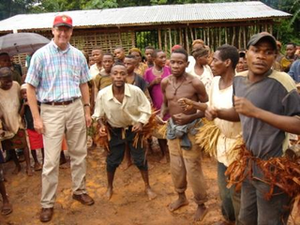December 21, 2007 feature
Why Are Pygmies Short?

The question is controversial. Traditional explanations attribute pygmies' small stature to minimizing caloric requirements and walking in dense forests. However, a new study by researchers at the University of Cambridge suggests that there are some problems with this explanation, and offers an alternative hypothesis.
Human pygmy populations are defined by an average male height of less than 5 feet (155 cm). By this definition, a wide range of pygmy societies exist today in parts of Africa, Malaysia, Thailand, Brazil, and Bolivia – different environments that don’t match the traditional hypotheses for small body size.
Besides the differences within pygmy populations, there are also some non-pygmy populations that face some of the same physical challenges as pygmies but haven’t evolved a short stature. For example, many human populations live in dense forests and experience regular food shortages, and yet these populations have larger body sizes.
Now, scientists Andrea Migliano, Lucio Vinicius, and Marta Lahr have performed a study on two pygmy groups from the Philippines, the Aeta and the Batak, and concluded that there may be a better explanation for pygmies’ short stature. Their study is published in a recent issue of the Proceedings of the National Academy of Sciences.
The researchers point out that one characteristic unique to but common among many pygmy populations is their short lifespan compared to other humans. With this in mind, the researchers suggest that pygmies represent the “fast” extreme of life history strategies, with short stature being a side effect.
“We first thought that we would find a relationship between small body size and increased fitness in pygmies – for example, that the shorter pygmies would have more advantages, such as higher fertility, than the taller ones,” Migliano told �鶹��ԺOrg.com. “However, the smaller pygmies had lower fertility than the taller pygmies. So this gave us the idea that perhaps there was no advantage in being short among pygmies.
“Then, when I went to the field, and started to interview them, I noticed the very high mortality rates – really high compared to any other population,” she said. “So when we checked that different pygmy groups followed the same pattern, we thought that these facts should be linked. Also, life history theory has been used for a long time to understand body size diversity among mammals, and we thought it should also apply to the understanding of human diversity.”
Because of their short life expectancies, the researchers speculate that pygmies have had to shift their reproductive years forward. The average life expectancy at birth for different pygmy populations ranges from just 16 years to 24 years. Very few pygmy women reach the end of their reproductive period, as only a small percentage survive past age 40.
In order to compensate for the lack of older reproductive women, natural selection has shifted the reproductive period forward. The fertility peak of age at first reproduction in the Aeta is around 15 years old, which reduces generation time and compensates for their short lifespan.
In order to make this fertility shift, pygmies must reach full maturity faster than longer-lived human populations. For this reason, many pygmies stop growing at about age 12, several years earlier than other humans. Their childhood growth rate isn’t any more or less rapid than the growth rate of other (traditional) humans; pygmy youth are roughly the same size as non-pygmy youth. (This is the opposite of what is observed in cases of nutritionally induced stunting, where humans delay growth but achieve adult body size later). Instead of experiencing the “teenage growth spurt,” pygmies’ growth is simply truncated.
Migliano also explained why pygmies’ growth rates don’t increase in the early years to compensate for their truncated growth at an early age.
“I think that, besides the high mortality, they have very low calorie intake, so it is a combination of the two factors that lead to the different phenotypes,” she said. “The pygmies grow in the same rates as the Turkana [eastern African Pastoralists], who also suffer from poor nutrition – but because the Turkana have longer life expectancy, they have time to grow for longer and achieve larger body size. I would expect that a population with high mortality and high resources would grow fast and taller.” In other words, human height in general is partially influenced by lifespan.
Still, the life history hypothesis leaves a few unanswered questions. For one, what originally caused the extremely high mortality rates among pygmies? The researchers suspect that the traditional hypotheses of environment, nutrition, thermoregulation, and other challenges may jointly or partially contribute to the high mortality rates observed in a wide variety of pygmy populations. In that case, the traditional explanations may be indirect causes of pygmies’ short stature, although the chain of effects would be much more complex than originally thought.
More information: Migliano, Andrea Bamberg, Vinicius, Lucio, and Lahr, Marta Mirazon. “Life history trade-offs explain the evolution of human pygmies.” Proceedings of the National Academy of Sciences. December 18, 2007. vol. 104, no. 51, 20216-20219.
Copyright 2007 �鶹��ԺOrg.com.
All rights reserved. This material may not be published, broadcast, rewritten or redistributed in whole or part without the express written permission of �鶹��ԺOrg.com.




















